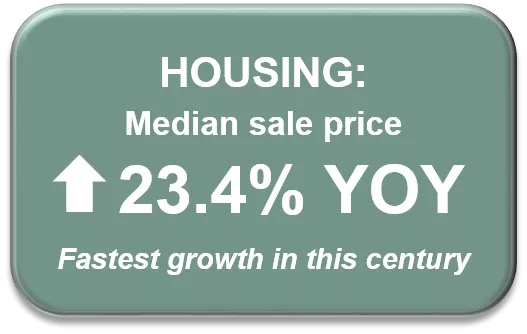August Economic Commentary: Strong Growth Constrained by Multiple Factors

Chief Economist
Pohlad Companies
The latest batch of economic reports have provided confirmation of strong growth in 2Q-21. The related story is that growth could have been even stronger without the ongoing supply chain bottlenecks and labor shortages. In addition to keeping activity below potential, these constraints are causing inflationary pressures to reach decade-long highs, thus putting added focus on potential changes in the Fed’s monetary policy. In the following review of recent economic activity, one needs to remember that none of these reports incorporate the impact of the accelerating emergence of the Delta variant of the COVID virus.
GDP Growth
The first reading of 2Q-21 Real GDP showed that the economy grew at a 6.5% annualized rate following the 6.3% increase in 1Q-21. 2Q-21 growth was expected to be stronger, but the constraints mentioned above held back activity. The economy, as measured by Real GDP, has just surpassed its previous peak from 4Q-2019. As a result of unprecedented fiscal and monetary policy actions, we have recovered from the largest peak-to-trough decline in history in record time. Having recovered the lost output from the recession, we are now back in line with the long-term trend of GDP growth and should expect upcoming quarterly reports in 2022 to reflect growth to be more in line with 2.0% - 3.5% growth. This doesn’t mean the recovery is stalling, it’s just that the economy is getting back to more normal growth rates.
The primary driver of GDP growth in 2Q-21 was personal consumption expenditures, which grew at an annualized +11.8% rate fueled by the $1.9 trillion stimulus package passed in March. Much of this spending was concentrated in the early part of the quarter.
Inflation
The persistence of the current inflation surge remains the topic of the day. Headline CPI inflation is at a decade-high 5.4% as of June, and the Core Personal Consumption Expenditure Index (CPCE, the Fed’s preferred measure) is at a 30-year high of 3.5%.
The categories most sensitive to the re-opening of the economy (rental cars, airfares, used cars, and lodging) account for the majority of increased price pressures in the CPI. This suggests that this surge in inflationary pressures is largely transitory and will diminish as supply and demand come back into balance.
More persistent inflationary pressures will require wages to accelerate. The Employment Cost Index (ECI) tracks total compensation and is growing 2.8% year over year—similar to its pre-COVID reading. The degree of acceleration in the ECI and sustainability of that acceleration will be key factors in the persistence of long-term inflationary pressures.
Inflation is growing faster than personal income, making it difficult for consumers to keep up with price increases without dipping into savings. The inflated cushion of savings developed as a result of COVID government stimulus checks is being reduced and is nearing pre-pandemic levels. With support from fiscal stimulus fading, and prices increasing faster than wage growth, expect consumer expenditures to slow in the second half of 2021.
Housing Market
The housing market remains hot. Low interest rates, tight inventories and high demand have been the driving forces. Inventory of homes for sale is down 19% year over year. Median sales prices are rising at 23.4% year over year—the fastest rate this century.
Employment
The July employment report showed a gain of 943,000 in non-farm payrolls with upward revisions to the previous two months. Gains were highest in the leisure/hospitality sector. Payrolls are still 5.7 million lower than February 2020, but at this pace the Fed’s requirement of “substantial improvement” in the labor market could be met sooner than expected. The unemployment rate dropped to 5.4% from 5.9% as job increases exceeded the increase in the size of the labor force. The participation rate showed only slight improvement, indicating large numbers still staying out of the labor force. Average hourly earnings are growing 4.0% year over year, and with surveys suggesting that firms are struggling to hire qualified workers, upward pressure on wage growth is likely to continue.
Looking Forward
The improving employment numbers and elevated inflation numbers are putting pressure on the Fed to reduce the Quantitative Easing (QE) program they’ve employed since last year. Expect some Fed guidance to come from their Jackson Hole meeting at the end of August or their next FOMC meeting in September. Remember, all of these reports were based on data before the recent acceleration of the Delta variant. The virus remains the biggest threat to the outlook. While it is unlikely that the resurgence of the virus will derail the recovery, it may certainly slow it down.
Insights
Research to help you make knowledgeable investment decisions
